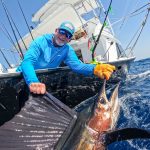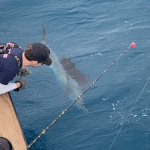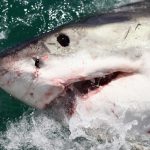Updated Videos on ROFFS™.com – Be Sure to Check Out the “Hot News” Button on the ROFFS™ Homepage
Just Another Day at the Office!

Still beats a 9-5 office job. Video Courtesy: John Evans | Facebook
Please click HERE to watch the video on our website now!
Baby Shark Bite!

When holding a baby shark goes wrong…Video Courtesy: You Just Broke the Internet | Facebook
Please click HERE to watch the video on our website now!
Letter to the Editor: Indian River Lagoon Ecosystem Disaster and Education
March 29, 2016
Dear Editor:
Indian River Lagoon Ecosystem Disaster and Education
We have a three billion dollar ($3.7B) ecosystem economic machine called the Indian River Lagoon (IRL) in Brevard County, central east Florida, as part of the Space Coast. Unfortunately we (the public and managers) have not done enough to maintain its health as we have an over abundance of nitrogen and phosphorus in our estuary system, along with algae blooms and dead sea grass. The result has been a substantial brown algae bloom and when the algae dies and/or respires at night under warming and low wind conditions, the dissolved oxygen levels approach zero. The result has been a tremendous and extensive fish kill. For more details see the short video “Fish Kill in Banana River Lagoon” below:

Above: Fish kill in the Banana River lagoon that happened over the weekend due to high nutrient levels feeding an ongoing brown algae bloom, that depleted the dissolved oxygen. Video Courtesy: cnc66 | YouTube
Please click HERE to watch the video on our website now!
This has received moderate national media attention. But we think it needs greater attention and action. We are concerned about this due to the poor long-term prospects of this estuary’s ecosystem services since it is in our backyards. But we are also concerned that this is a growing trend in the United States and it seems that most people do not understand that the causes are preventable and even reversible if caught in time. Estuaries are critical for providing fundamental life-support processes, including filtration and fish nurseries, as well as, habitats for birds, non-human mammals and human recreation. Estuaries are nurseries for many offshore species such as tarpon, snapper and grouper. See more on why estuaries are important online at NOAA’s site using this link.
For us (and many other educated people) we see that investment in protecting our estuaries is at a minimal level and has been for too long a period. People assume that the our waters will automatically be clean and that the ecosystems will be healthy by default. We expect and plan for the tourist and use dollars as a major tax base. Many businesses and communities depend on healthy estuarine ecosystems. Well, maybe 500 years ago one could expect that the estuaries would be clean by default with no protection needed. But our estuaries appear to be more like a valuable car that one does not do enough servicing on until a hose breaks. Then one realizes that the engine and transmission are blown too. It hurts to pay the bill, but you have to.
Please click HERE to read more about the Indian River Lagoon Disaster on our website now!
Another Video: Fertilizing Beside Dead Fish

Above: Please help stop this! Thank YOU! Video Courtesy: Dylan Hansen | BalanceForEarth.org | YouTube
Please click HERE to watch the video on our website now!
Another Video: Indian River Lagoon Fish Kill!

Above: “I’ve lived here all my life and I haven’t seen it this bad ever.” Fish are dying at an alarming rate around the Indian River Lagoon, and residents said it’s the worst fish kill they’ve ever seen: http://at.wftv.com/22ALPkk – Video Courtesy: WFTV Channel 9 | Facebook
Please click HERE to watch the video on our website now!
Just Looking!

Pink flamingo flashmob…Video Courtesy: EARTH channel | Facebook
Please click HERE to watch the video on our website now!

Please click HERE to watch the video on our website now!
Updated Client Photos

Please click HERE to our newly updated 2016 client photo gallery on our website now!
Northeastern U.S. – Early Spring Special
We are providing another complimentary analysis of the overall ocean conditions from Tuesday, March 29th for the canyon areas offshore of Massachusetts, Rhode Island, Connecticut to New York and northern New Jersey to provide some motivation to get ready for the fishing season. We have included some spot sea surface temperatures (°F) and located the main eddy features with arrows indicating the flow direction of the water. Overall, we continue to monitor the large clockwise rotating Gulf Stream Warm Core Ring Eddy now centered south between Hydrographer and Veatch Canyon. Updating the conditions from earlier in March, we are encouraged that this large eddy has remained intact and continues to slowly move westward as it is now pushing mixed Gulf Stream (60°F-63°F) water directly into Veatch and Hydrographer Canyon. Furthermore, there is a large amount of 60°F water farther west over the 100-500 fathom ledges between West Atlantis Canyon and Block Canyon for some decent early season shark and bluefin tuna action. If this large Gulf Stream Warm Core Eddy continues on its path as we expect, it will be pushing Gulf Stream 60°F-65°F water directly into the Atlantis Canyons within the next couple of weeks, then will continue to move west-southwestward and be into the Fish Tails to Dip area by late April and May. Farther southeast, of note, is the proximity of the direct Gulf Stream related waters (60°F-62°F-64°F) to the 1000 fathom ledges of Spencer, Wilmington and Lindenkohl Canyons encouraging some early season fishing action as the main Gulf Stream waters have pushed farther north than normal for this area. Keep in mind, with this being a warmer than normal El Nino winter for the Northeast, it should also equate to an earlier than normal arrival for tuna, wahoo, dolphin and billfish action into this area. Therefore, get your boats ready, do not miss out on some early season tuna, shark and swordfish action. Contact ROFFS™ and get the up-to-date integrated fishing forecasting analysis to locate the best conditions for fishing action near you.

Please click here to view the full high resolution analysis on our website now!NOTICE: AL – DAUPHIN ISLAND – Naval Testing
Commencing approximately March 28, 2016 and continuing until approximately April 16, 2016, the Naval Research Laboratory will deploy research equipment at 6 mooring locations. The planned locations of the moorings are in approximate positions:
Mooring (1), 30-10-28.16N 088-01-07.57W
Mooring (2), 30-10-57.00N 088-04-40.51W
Mooring (3), 30-12-03.49N 088-07-22.15W
Mooring (4), 30-07-46.13N 088-07-23.09W
Mooring (5), 30-03-06.80N 088-07-18.91W
Mooring (6), 29-58-40.01N 088-07-16.00W
Mooring (1) will extend 2 feet off bottom. Moorings (2) and (3) will extend with a line to just below the ocean surface. Moorings (4), (5), and (6)
will extend with a line to 30-foot below surface. Nine inch in diameter white buoys with a flashing yellow 2.2s, light characteristic will be deployed to mark these subsurface moorings. Mariners are asked to not disturb these experiments and are urged to use caution when transiting the area.
Backlash? Feedback?

As always, please send comments & feedback on Fishy Times newsletter content directly to us at feedback@roffs.com.
If you do not want to wait for our next Fishy Times newsletter, please visit us in the meantime to get all your fishing news on Facebook, Instagram, Twitter, YouTube and on the web. Safe and successful fishing until next time!






